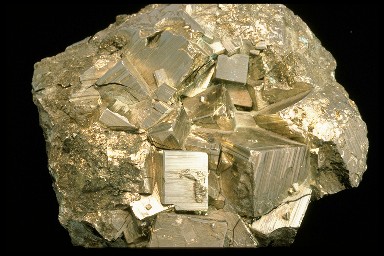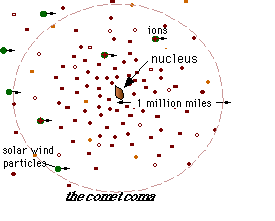Plasma: the negatively charged electrons (yellow) are freely
streaming through the positively charged ions (blue).
General Atomics
The Plasma State
Plasma is known as the
fourth state of matter. The other three states are solid, liquid and gas.
In most cases, matter on Earth has electrons that orbit around the atom's nucleus. The negatively charged electrons are attracted to the positively charged nucleus. Remember, opposites attract! So the electrons stay in orbit around the nucleus. When temperatures get REALLY hot, the electrons can escape out of their orbit around the atom's nucleus. When the electron(s) leave, that leaves behind what scientists call a positively charged ion. This whole process is similar to a spacecraft that escapes the Earth's gravitational pull.
In summary, when electrons are no longer trapped in orbits around the nucleus, we have the plasma state. This is when a gas becomes a bunch of electrons which have escaped the pull of the nucleus and ions which are positively charged because they have lost one or more electrons.
Most of the matter in the universe is found in the plasma state. That is because stars contain so much of the matter in the universe (stars are so hot that their matter can only exist in the plasma state).
You might also be interested in:

Solid is one of the four common states of matter. The three others are gas, liquid, and plasma. There are also some other exotic states of matter that have been discovered in recent years. Unlike liquids
...more
As the ices of the comet nucleus evaporate, they expand rapidly into a large cloud around the central part of the comet. This cloud, called the coma, is the atmosphere of the comet and can extend for millions
...more
The plasma sheet is just that, a sheet of plasma that extends down the magnetotail dividing the two lobes of the Earth's magnetic field. This outer plasma is hotter than the plasma in the plasmasphere,
...more
The plasmasphere is a donut-shaped region inside the Earth's magnetosphere. It is basically an extension of the ionosphere, or the topmost part of the Earth's atmosphere. The magnetic field lines of the
...more
The solar core is made up of a really hot and dense gas (in the plasma state). The temperature of 15 million kelvins (27 million degrees Faranheit) keeps the core at a gaseous state. The core is where
...more
Most of the energy we receive from the Sun is the visible (white) light emitted from the photosphere. The photosphere is one of the coolest regions of the Sun (6000 K), so only a small fraction (0.1%)
...more
The gas in the solar corona is at very high temperatures (typically 1-2 million kelvins in most regions) so it is almost completely in a plasma state (made up of charged particles, mostly protons and electrons).
...more















